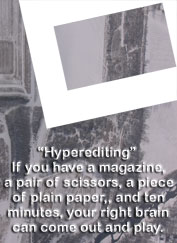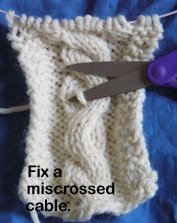.
I've always had a peripheral interest in cuneiform. I thought it would be cool to learn to read it -- until I paid attention to the fact that ancient clay tablets were not written in English.
Oh.
Right.......
I have no interest in learning Akkadian (or Sumarian, or Hittite)............
But wouldn't it be cool to be able to read the word "Hammurabi"? Or, wouldn't it be cool to be able to read whatever the most common word in Akkadian is? So you might recognize at least one word, when you looked at a clay tablet? I think it would be.........
Given this long-standing interest, I was quite pleased to discover that one of the assignment choices for Unit 2 of Archeology's Dirty Little Secrets is to write something in cuneiform!
Cuneiform is written in syllabograms -- each collection of wedge-shaped marks is a syllable. We were given a link to a long list of syllable/cuneiform pairs.
http://www.britishmuseum.org/pdf/cuneiform.pdf
At a minimum, we are to write our names.....
I looked at the list. No V. Hardly a surprise -- many current languages don't have V. No F........ Hmmm. At this point, I'm thinking writing my name may not be that great an idea.
Then I thought of the fact that cuneiform was not meant for English........
(Digression: Interestingly, as I looked for translation, I read that cuneiform was not very well suited to Akkadian, either! According to Wikipedia, "Cuneiform was in many ways unsuited to Akkadian: among its flaws was its inability to represent important phonemes in Semitic, including a glottal stop, pharyngeals, and emphatic consonants. In addition, cuneiform was a syllabary
writing system — i.e. a consonant plus vowel comprised one writing unit
— frequently inappropriate for a Semitic language made up of triconsonantal roots (i.e. three consonants plus any vowels)."
Standards are excellent, but sometimes slavish adherence to a standard can enough trouble that it might be worth it to abandon the standard...................
End of Digression.)
Back to the assignment -- I decided to write "dirty little secrets" in Akkadian.
It was easy to find an English->Akkadian dictionary online.
http://www.premiumwanadoo.com/cuneiform.languages/dictionary/search.php
Akkadian has S with an upside-down carat over it, and S with a dot under it. (The S in esu had one of those dots under it.) The list of syllable/cuneiform pairs at the British Museum doesn't have either; it just has plain S....
I don't know how a line over A (or E) affects which syllables I ought to have chosen (or if the ones I need is even in the list).
Soldiering on, despite these obstacles, I arrived at the following plan. The mostly-English text is from the dictionary, and the syllable/cuneiform pairs are from the British Museum's list.
I thought it might be cool to write 2013 under the words, but I changed my mind after trying to find out how to write 2013 -- according to Wikipedia, "The numerals 1 and 2 as well as 21–29, 31–39, 41–49 correspond with the counted in the grammatical gender,
while the numerals 3–20, 30, 40 and 50 show gender polarity, i.e. if
the counted noun is masculine, the numeral would be feminine and vice
versa. This polarity is typical of the Semitic languages and appears also in classical Arabic
for example. The numerals 60, 100 and 1000 don't change according to
the gender of the counted noun. Counted nouns more than two appear in
the plural form. However, body parts which occur in pairs appear in the dual form in Akkadian. e.g. šepum (foot) becomes šepān (two feet)."
All righty then. Never mind! Way more complexity needed to express a number than I wish to undertake! (Not to mention that "2013" introduces a completely different time-keeping scheme than than Hammurabi and Company would have been using!).
The course material included videos of people writing cuneiform on air-dry clay with a square-ended chopstick. We were shown how to make three wedge-shaped marks -- horizontal, vertical, and diagonal -- any of which may have long or short tails.
Attempting to copy the cuneiform above with a pen and paper, we notice right away that some of the marks have TWO tails. We were not shown how to make marks like that.... I'm guessing the stylus went into the wedge part of the shape twice, in each of two orientations, but I don't know..................
I bought some air-dry clay. I dug a square-ended chopstick out of the "miscellaneous kitchen tools" drawer.
Practice marks, with esu written at the bottom.
I wish I could have used real clay. I love real clay, but real clay requires a real kiln...... Air-dry "clay" has a completely
different feel. It is much harder to smooth. It resists the marks (recovering a bit, rather than holding the mark-as-made). Erasing mistakes is something it's not interesting in facilitating.....
Without further ado -- dirty little secrets:
Wouldn't it be fun to know if one of those ancient scribes could read what I wrote, and understand what I meant?
Final impressions:
* The prep took WAY longer than the doing.
* Making these marks is easy and quick, but it would take even a very fast scribe a lot longer to write cuneiform than cursive English, say.
* I might change my mind if I were more familiar with a syllabographic language, but I'm thinking that a one-set-of-marks-per-sound system is simpler and cleaner than a one-set-of-marks-per-syllable system.
This was fun, and I'm glad I did it!
.
Subscribe to:
Post Comments (Atom)




















2 comments:
This is pretty cool -- extending beyond my power to even comprehend, almost! Just glad you didn't write the date! The end piece looks great!
Thanks! It was interesting, working through the whole process, and fun making the marks.........
What a great assignment! :-)
Post a Comment